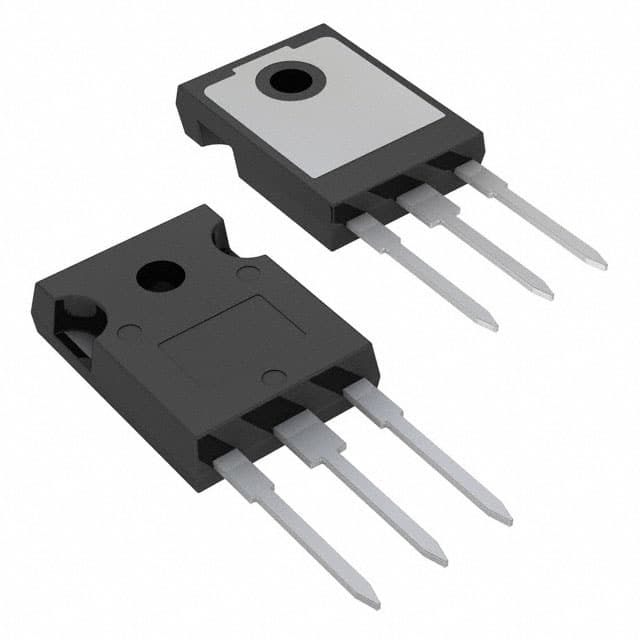Viz Specifikace pro podrobnosti o produktu.

IRFP3710PBF
Product Overview
Category
The IRFP3710PBF belongs to the category of power MOSFETs.
Use
It is commonly used in high-power applications such as power supplies, motor control, and inverters.
Characteristics
- High voltage capability
- Low on-resistance
- Fast switching speed
- High input impedance
Package
The IRFP3710PBF is typically available in a TO-247AC package.
Essence
This power MOSFET is essential for efficient power management in various electronic systems.
Packaging/Quantity
It is usually packaged in tubes or reels with quantities varying based on manufacturer specifications.
Specifications
- Drain-Source Voltage (VDS): 100V
- Continuous Drain Current (ID): 57A
- On-Resistance (RDS(on)): 23mΩ
- Gate-Source Voltage (VGS): ±20V
- Total Gate Charge (Qg): 76nC
- Operating Temperature Range: -55°C to 175°C
Detailed Pin Configuration
The IRFP3710PBF features a standard three-pin configuration: 1. Gate (G) 2. Drain (D) 3. Source (S)
Functional Features
- High voltage capability allows for use in demanding applications.
- Low on-resistance minimizes power loss and improves efficiency.
- Fast switching speed enables rapid response in control systems.
Advantages
- Suitable for high-power applications
- Efficient power management
- Fast switching speed
Disadvantages
- Higher cost compared to lower-rated MOSFETs
- May require additional heat dissipation measures in high-power applications
Working Principles
The IRFP3710PBF operates based on the principle of field-effect transistors, where the voltage applied to the gate terminal controls the flow of current between the drain and source terminals.
Detailed Application Field Plans
The IRFP3710PBF is widely used in the following applications: - Power supplies - Motor control systems - Inverters for renewable energy systems - Industrial automation equipment
Detailed and Complete Alternative Models
Some alternative models to the IRFP3710PBF include: - IRFP460PBF - IRFP250PBF - IRFP240PBF
In conclusion, the IRFP3710PBF power MOSFET offers high voltage capability, low on-resistance, and fast switching speed, making it suitable for various high-power applications such as power supplies, motor control, and inverters. While it has advantages in terms of efficiency and performance, it may have higher costs and require additional heat dissipation measures in certain applications. Understanding its working principles and considering alternative models can help in optimizing its use in different electronic systems.
Seznam 10 běžných otázek a odpovědí souvisejících s aplikací IRFP3710PBF v technických řešeních
What is the maximum drain-source voltage of IRFP3710PBF?
- The maximum drain-source voltage of IRFP3710PBF is 100V.
What is the continuous drain current rating of IRFP3710PBF?
- The continuous drain current rating of IRFP3710PBF is 57A.
What is the on-state resistance (RDS(on)) of IRFP3710PBF?
- The on-state resistance (RDS(on)) of IRFP3710PBF is typically 23mΩ at VGS = 10V.
What is the gate-source voltage (VGS) range for IRFP3710PBF?
- The gate-source voltage (VGS) range for IRFP3710PBF is ±20V.
Is IRFP3710PBF suitable for high-frequency switching applications?
- Yes, IRFP3710PBF is suitable for high-frequency switching applications due to its low on-state resistance and fast switching characteristics.
Does IRFP3710PBF require a heatsink for operation?
- Yes, IRFP3710PBF may require a heatsink for efficient heat dissipation, especially in high-power applications.
What are the typical applications of IRFP3710PBF?
- Typical applications of IRFP3710PBF include power supplies, motor control, DC-DC converters, and inverters.
What is the operating temperature range of IRFP3710PBF?
- The operating temperature range of IRFP3710PBF is -55°C to 175°C.
Can IRFP3710PBF be used in automotive applications?
- Yes, IRFP3710PBF is suitable for automotive applications such as motor control and power management.
Is IRFP3710PBF RoHS compliant?
- Yes, IRFP3710PBF is RoHS compliant, making it suitable for use in environmentally sensitive applications.

